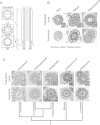Bioinformatic analysis of ciliary transition zone proteins reveals insights into the evolution of ciliopathy networks
- PMID: 24969356
- PMCID: PMC4092220
- DOI: 10.1186/1471-2164-15-531
Bioinformatic analysis of ciliary transition zone proteins reveals insights into the evolution of ciliopathy networks
Abstract
Background: Cilia are critical for diverse functions, from motility to signal transduction, and ciliary dysfunction causes inherited diseases termed ciliopathies. Several ciliopathy proteins influence developmental signalling and aberrant signalling explains many ciliopathy phenotypes. Ciliary compartmentalisation is essential for function, and the transition zone (TZ), found at the proximal end of the cilium, has recently emerged as a key player in regulating this process. Ciliary compartmentalisation is linked to two protein complexes, the MKS and NPHP complexes, at the TZ that consist largely of ciliopathy proteins, leading to the hypothesis that ciliopathy proteins affect signalling by regulating ciliary content. However, there is no consensus on complex composition, formation, or the contribution of each component.
Results: Using bioinformatics, we examined the evolutionary patterns of TZ complex proteins across the extant eukaryotic supergroups, in both ciliated and non-ciliated organisms. We show that TZ complex proteins are restricted to the proteomes of ciliated organisms and identify a core conserved group (TMEM67, CC2D2A, B9D1, B9D2, AHI1 and a single TCTN, plus perhaps MKS1) which are present in >50% of all ciliate/flagellate organisms analysed in each supergroup. The smaller NPHP complex apparently evolved later than the larger MKS complex; this result may explain why RPGRIP1L, which forms the linker between the two complexes, is not one of the core conserved proteins. We also uncovered a striking correlation between lack of TZ proteins in non-seed land plants and loss of TZ-specific ciliary Y-links that link microtubule doublets to the membrane, consistent with the interpretation that these proteins are structural components of Y-links, or regulators of their formation.
Conclusions: This bioinformatic analysis represents the first systematic analysis of the cohort of TZ complex proteins across eukaryotic evolution. Given the near-ubiquity of only 6 proteins across ciliated eukaryotes, we propose that the MKS complex represents a dynamic complex built around these 6 proteins and implicated in Y-link formation and ciliary permeability.
Figures


References
Publication types
MeSH terms
Substances
Grants and funding
LinkOut - more resources
Full Text Sources
Other Literature Sources

